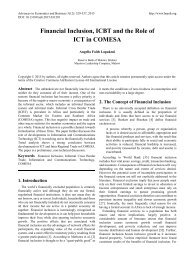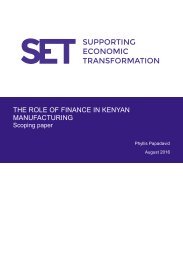FD
gvti301SEaf
gvti301SEaf
Create successful ePaper yourself
Turn your PDF publications into a flip-book with our unique Google optimized e-Paper software.
an email discussion list of activists who believed that<br />
cryptography could bring about social and political<br />
change (“cypherpunks”). Others became interested<br />
and soon started to develop the idea online.<br />
Bitcoin started trading in 2009, with an exchange<br />
rate against the U.S. dollar of $0.0007 per bitcoin.<br />
In February 2011, it reached parity with the dollar.<br />
In November 2013, the value of bitcoin peaked at<br />
$1,242, and it has been trading above $400 for most<br />
of 2016. The value of bitcoin in circulation is about<br />
$6 billion (compared with about 1.5 trillion U.S. dollars<br />
in circulation worldwide).<br />
In the beginning, bitcoin grabbed the imagination<br />
of libertarians who wanted to get rid of, or at least<br />
have an alternative to, banks and central banks. While<br />
the exchange rate surge triggered something of a gold<br />
rush, bitcoin’s relative anonymity and ease of trading<br />
attracted drug dealers and other criminals, leading to<br />
a heavy law enforcement crackdown during 2013 and<br />
2014 that landed some early entrepreneurs in jail and<br />
gave the whole initiative a bad reputation.<br />
Tech entrepreneurs and the financial industry<br />
soon realized that the real news was under the<br />
hood—bitcoin’s underlying distributed ledger technology.<br />
Essentially, this is a technology for verifying<br />
and recording transactions on a peer-to-peer basis<br />
without a central authority. It upends a very basic<br />
tenet of payment systems: having one central, independent,<br />
and trusted bookkeeper that stores and<br />
validates all transactions—a role often played by<br />
central banks (see Centralized chart). payment systems<br />
With bitcoin, everyone on the Internet can validate<br />
and record transactions in their own copy of the<br />
Anriano, 4/15/16<br />
ledger. They group the transactions during a given<br />
period into a block, which is followed by a tamperproof<br />
stamp. Each transaction block links to a block<br />
for the previous period—hence the term “blockchain.”<br />
Completing the block for a period requires<br />
Box 1<br />
You got money<br />
Several start-ups are already delivering small payments and remittance<br />
services at low cost using bitcoin as a payment system, not a currency.<br />
Rather than charging 8 percent to send remittances, the start-up Circle<br />
Internet Financial, for example, performs the service free. Its sleek mobile<br />
app incorporates social media features like sending pictures and emojis<br />
together with a payment notification—appealing to a younger demographic<br />
accustomed to expressing itself in smileys.<br />
Users link their profile to a bank account or card on each end of the<br />
transaction and simply “text” money to each other anywhere in the world.<br />
Transactions are conducted via bitcoin, but the user doesn’t need to know<br />
how it happens. If the receiver is not in the bitcoin system, the money can<br />
still be retrieved with other “digital wallets” (apps that allow the storage of<br />
bitcoin or other currency on a smartphone) or at the counters of remittance<br />
companies for a small fee, provided they also deal in bitcoin.<br />
“It’s like with sending an email,” says the Circle CEO, Jeremy Allaire.<br />
“You don’t care about how the message is routed through the Web.”<br />
He explains how his Filipino nanny in California used to spend about<br />
$50 for each remittance home and now pays $0.75, and that much only<br />
because her family at the other end of the transaction doesn’t use Circle.<br />
Because transactions happen very quickly, bitcoin’s well-known volatility<br />
is not really an issue.<br />
Circle combines the digital appeal with some good old “real” features. It<br />
is registered as a money service business, which allows it to provide many<br />
banking services, except lending and investing clients’ money, and enjoys<br />
deposit protection from the U.S. government. It recently became licensed<br />
in the United Kingdom and formed a partnership with Barclays Bank.<br />
Like many start-up honchos in the Internet’s early days, Allaire, whose<br />
coffers are well funded by venture capitalists, is not concerned with<br />
short-term profitability. “Our business is entering a market that generates<br />
trillions of dollars of revenue a year for retail banks. There’s absolutely<br />
huge amounts of market share to be disrupted or to be accessed<br />
with digital banking products,” he says. Didn’t many companies fail in<br />
the early 2000s by focusing too much on acquiring customers and too<br />
little on monetizing them? “The most significant Internet companies,<br />
they all started by focusing relentlessly on providing a free consumer<br />
utility that really delivered a lot of value for consumers. And they did it<br />
for several years until it got to a meaningful scale,” he adds.<br />
Spreading the burden<br />
In traditional banking, the central bank tracks payments between clients; in blockchain banking, transactions are recorded on<br />
multiple network computers and settled by many individuals.<br />
Centralized payment system<br />
Blockchain (distributed ledger) system<br />
Ledger<br />
Ledger<br />
Bank<br />
Bank<br />
Ledger Ledger Ledger Ledger<br />
Bank<br />
Central Bank<br />
Bank<br />
Ledger<br />
Ledger<br />
Finance & Development June 2016 45














